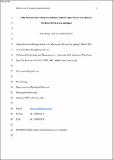Files in this item
Why human environments enhance animal capacities to use objects : evidence from keas (Nestor notabilis) and apes (Gorilla gorilla, Pan paniscus, Pongo abelii, Pongo pygmaeus)
Item metadata
| dc.contributor.author | Cheng, Ken | |
| dc.contributor.author | Byrne, Richard William | |
| dc.date.accessioned | 2018-07-20T11:30:05Z | |
| dc.date.available | 2018-07-20T11:30:05Z | |
| dc.date.issued | 2018-07-19 | |
| dc.identifier | 252576244 | |
| dc.identifier | ffbbf0e6-255a-4419-89ba-eb617fce4c5f | |
| dc.identifier | 85050140885 | |
| dc.identifier | 000450298000008 | |
| dc.identifier.citation | Cheng , K & Byrne , R W 2018 , ' Why human environments enhance animal capacities to use objects : evidence from keas ( Nestor notabilis ) and apes ( Gorilla gorilla , Pan paniscus , Pongo abelii , Pongo pygmaeus ) ' , Journal of Comparative Psychology , vol. Advance Online . https://doi.org/10.1037/com0000121 | en |
| dc.identifier.issn | 0735-7036 | |
| dc.identifier.other | ORCID: /0000-0001-9862-9373/work/60630590 | |
| dc.identifier.uri | https://hdl.handle.net/10023/15609 | |
| dc.description.abstract | Formal training programs, which can be called education, enhance cognition in human and nonhuman animals alike. However, even informal exposure to human contact in human environments can enhance cognition. We review selected literature to compare animals’ behavior with objects among keas and great apes, the taxa that best allow systematic comparison of the behavior of wild animals with that of those in human environments such as homes, zoos, and rehabilitation centers. In all cases, we find that animals in human environments do much more with objects. Following and expanding on the explanations of several previous authors, we propose that living in human environments and the opportunities to observe and manipulate human-made objects help to develop motor skills, embodied cognition, and the use of objects to extend cognition in the animals. Living in a human world also furnishes the animals with more time for such activities, in that the time needed for foraging for food is reduced, and furnishes opportunities for social learning, including emulation, an attempt to achieve the goals of a model, and program-level imitation, in which the imitator reproduces the organizational structure of goal-directed actions without necessarily copying all the details. All these factors let these animals learn about the affordances of many objects and make them better able to come up with solutions to physical problems. | |
| dc.format.extent | 1252608 | |
| dc.language.iso | eng | |
| dc.relation.ispartof | Journal of Comparative Psychology | en |
| dc.subject | Human environment | en |
| dc.subject | Object manipulation | en |
| dc.subject | Physical cognition | en |
| dc.subject | Embodied cognition | en |
| dc.subject | Extended cognition | en |
| dc.subject | BF Psychology | en |
| dc.subject | QL Zoology | en |
| dc.subject | T-NDAS | en |
| dc.subject.lcc | BF | en |
| dc.subject.lcc | QL | en |
| dc.title | Why human environments enhance animal capacities to use objects : evidence from keas (Nestor notabilis) and apes (Gorilla gorilla, Pan paniscus, Pongo abelii, Pongo pygmaeus) | en |
| dc.type | Journal article | en |
| dc.contributor.institution | University of St Andrews. School of Psychology and Neuroscience | en |
| dc.identifier.doi | 10.1037/com0000121 | |
| dc.description.status | Peer reviewed | en |
| dc.date.embargoedUntil | 2018-07-19 |
This item appears in the following Collection(s)
Items in the St Andrews Research Repository are protected by copyright, with all rights reserved, unless otherwise indicated.

